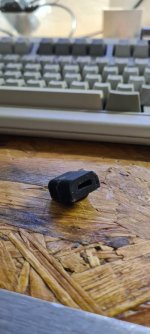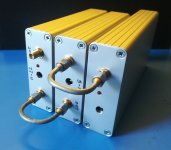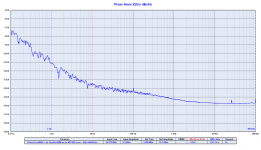thanks for sharing Gabor
what were the "old" clocks you compared to?
dis you try difference between 44.1 and 192 with same tracks but rendered at those speeds. Linn studio for example does this and makes comparison nice and easy
The old Driscoll boards with SC-cut crystals (45/49) were the clocks before.
I'll try to compare what you wrote.
We cannot measure the phase noise in all the possible environments, we have measured them in our environment.
The measurements have been made with the devices boxed and connected as in the attached picture.
We have used RG400 SMA terminated coaxial cables.
All the devices was powered by batteries.
EMI/RFI interferences are different in different environments.
Ground loops are usually related to the whole system.
Every implementation is different from the other, so it's difficult to generalize.
The measurements have been made with the devices boxed and connected as in the attached picture.
We have used RG400 SMA terminated coaxial cables.
All the devices was powered by batteries.
EMI/RFI interferences are different in different environments.
Ground loops are usually related to the whole system.
Every implementation is different from the other, so it's difficult to generalize.
Attachments
Hello Andrea,
Most of us will try to '' copy '' your set.
I will use one big supercap 61,7 F
Is it is possible to pick up interference by the power cables.
Of course interference in Milan city center will be different from a remote village in Sicily.
But it should work properly in a normal living room i hope.
Greetings, Eduard
Most of us will try to '' copy '' your set.
I will use one big supercap 61,7 F
Is it is possible to pick up interference by the power cables.
Of course interference in Milan city center will be different from a remote village in Sicily.
But it should work properly in a normal living room i hope.
Greetings, Eduard
We have measured the devices in a normal living room, nothing special and no bunker.
I forgot, please remove the plastic flanges from the Hammond box like in the previous picture.
I forgot, please remove the plastic flanges from the Hammond box like in the previous picture.
For those using the Hammond boxes, better RF shielding is possible by not using the plastic end pieces. One could also not drill out a hole for the LED. Lastly wrap the plastic power connector in some grounded copper foil. I don't know how much any of this matters but it couldn't hurt.
Hello Andrea,
You see this was already mentioned. I never had these Hammond boxes but for perfect screening my extruded tubes could be a little better because the rectangle is one part and has no separate panel. Of course one side can be closed airtight if you like.
The other end has some openings but i will try minimising them as much as possible.
Could interference enter the units by the power cables. Maybe they should not be twisted but screened. Just in case you room is a bit tricky concerning interference.
Greetings,Eduard
Hi eduard,
I have kinda learned how a little jitter sounds on my AK4499 dac. Its sort of a slightly bright sizzle on the sound, and a slight lack of focus; although not what I would call a blur exactly. That said, how it sounds also depends on how much jitter there is, and whatever else my be wrong with the dac.
I have kinda learned how a little jitter sounds on my AK4499 dac. Its sort of a slightly bright sizzle on the sound, and a slight lack of focus; although not what I would call a blur exactly. That said, how it sounds also depends on how much jitter there is, and whatever else my be wrong with the dac.
Last edited:
Hello,
So everyone should use all their knowledge and experience using these clocks. If things have problem solving properties they always should be shared.
Anyway start by copying the way Andrea did during testing.
Greetings,Eduard
So everyone should use all their knowledge and experience using these clocks. If things have problem solving properties they always should be shared.
Anyway start by copying the way Andrea did during testing.
Greetings,Eduard
WARNING
Although the Laptech crystals have strong mechanical construction since they are supplied in cold welded package, it would be a good practice avoiding any shock when handling the crystal.
A few tips:
- absolutely avoid that the crystal falls
- don't fold the legs
- use the pliers to lock the legs of the crystal before cutting them
- don't use resin core tin when soldering the crystal
Although the Laptech crystals have strong mechanical construction since they are supplied in cold welded package, it would be a good practice avoiding any shock when handling the crystal.
A few tips:
- absolutely avoid that the crystal falls
- don't fold the legs
- use the pliers to lock the legs of the crystal before cutting them
- don't use resin core tin when soldering the crystal
Wish I had seen this before I soldered them yesterday! Andrea, might be worth putting this into your PDF guide. I had a small drop off the crystal by 10-15 cm on to the table once before I put cushioning under.
How much folding of legs is bad?
How much folding of legs is bad?
Although the Laptech crystals have strong mechanical construction since they are supplied in cold welded package, it would be a good practice avoiding any shock when handling the crystal.
A few tips:
- absolutely avoid that the crystal falls
- don't fold the legs
- use the pliers to lock the legs of the crystal before cutting them
- don't use resin core tin when soldering the crystal
Wish I had seen this before I soldered them yesterday! Andrea, might be worth putting this into your PDF guide. I had a small drop off the crystal by 10-15 cm on to the table once before I put cushioning under.
How much folding of legs is bad?
Please, don't fold the legs anyway.
Cut the legs at the proper length and then use thin copper wire to connect the crystal to the board, especially for the 5/6 MHz crystals which have stronger legs and more difficult to fold.
I will update the user manual.
Hello,
It sounds like we are dealing with a MC cartridge.
Maybe cover the part of the board where the clock is mounted with a little cork '' element '' glued to the circuit with a cavity inside that will offer enough space for the clock to be isolated from airborne vibrations and keep it at a steady temperature. When you wrap it in a kind of foam the soldering, wires from the clock could be '' harmed ''
Greetings, Eduard
It sounds like we are dealing with a MC cartridge.
Maybe cover the part of the board where the clock is mounted with a little cork '' element '' glued to the circuit with a cavity inside that will offer enough space for the clock to be isolated from airborne vibrations and keep it at a steady temperature. When you wrap it in a kind of foam the soldering, wires from the clock could be '' harmed ''
Greetings, Eduard
Andrea Pourquoi ne pliez pas les pattes, pour le moment je soude les pattes du cristal,
et je les ai légèrement courbées pour que le cristal soit parallèle à la planche, mais pas de contrainte mécanique sur les pattes à la sortie du boitier Crystal, c'est un problème Andréa😕
https://zupimages.net/up/21/18/u0gk.jpg
et je les ai légèrement courbées pour que le cristal soit parallèle à la planche, mais pas de contrainte mécanique sur les pattes à la sortie du boitier Crystal, c'est un problème Andréa😕
https://zupimages.net/up/21/18/u0gk.jpg
Last edited:
One more tip:
please don't use oscillators and frequency doublers without proper shielding, use the suggested Hammond box or whatever metal enclosure you want, but don't leave them working on air.
EMI/RFI and even moving air heavily affect the close in phase noise performance of oscillators and frequency doublers.
please don't use oscillators and frequency doublers without proper shielding, use the suggested Hammond box or whatever metal enclosure you want, but don't leave them working on air.
EMI/RFI and even moving air heavily affect the close in phase noise performance of oscillators and frequency doublers.
Hello,
So we will hide the clock from view by attaching a piece of cork on top of the circuitboard with just a little cavity for the clock.
Probably the coils on the board will also be sensitive to vibrations are not?
Whatever metal?? Their should be differences between ferro and non-ferro or not.
If you wanna reduce the vibrations being transferred to the clock how to position the clock horizontally or vertically? If a the biggest part of wire between the clock output is formed by the original legs and there is just a tiny length of thin copper wire the effect of that copper wire will be small. So no bending at all from the original legs. Just use them for wire wrapping the thin copper wire.
If the length of the copper isnt critical, and the diameter is thin, it will be pretty simple to create a coil that will act like a spring.
IF everything is as critical as stated it wont be that stupid to try some things.
Already pretty sure i am going to create a kind of soundproof cork ( 50 mm thick) box to cover the 6 aluminium boxes. Of course there have to be one opening to supply DC to the big F and two RG400 cables going to the pair of sinus to square boards.
Greetings, Eduard
So we will hide the clock from view by attaching a piece of cork on top of the circuitboard with just a little cavity for the clock.
Probably the coils on the board will also be sensitive to vibrations are not?
Whatever metal?? Their should be differences between ferro and non-ferro or not.
If you wanna reduce the vibrations being transferred to the clock how to position the clock horizontally or vertically? If a the biggest part of wire between the clock output is formed by the original legs and there is just a tiny length of thin copper wire the effect of that copper wire will be small. So no bending at all from the original legs. Just use them for wire wrapping the thin copper wire.
If the length of the copper isnt critical, and the diameter is thin, it will be pretty simple to create a coil that will act like a spring.
IF everything is as critical as stated it wont be that stupid to try some things.
Already pretty sure i am going to create a kind of soundproof cork ( 50 mm thick) box to cover the 6 aluminium boxes. Of course there have to be one opening to supply DC to the big F and two RG400 cables going to the pair of sinus to square boards.
Greetings, Eduard
In order to better isolate the crystal from thermal variations and vibrations (mainly high freq ones) i have made some silicone casting of a shell that wraps snugly the HC body and then connects to the pcb via two small holes.
The silicone has a shore grade of 30 (very soft).
Silicone is a good thermal insulator and the mass added helps in smoothing vibrations out.
For low freq i have a stand solution that suspend the whole hammond box with nylon elastic band...
This is just a prototype... I have to fix some bubbling... Is a two piece mold... You can see the joining crease in the middle....
The silicone has a shore grade of 30 (very soft).
Silicone is a good thermal insulator and the mass added helps in smoothing vibrations out.
For low freq i have a stand solution that suspend the whole hammond box with nylon elastic band...
This is just a prototype... I have to fix some bubbling... Is a two piece mold... You can see the joining crease in the middle....

Make sure it's electrical grade silicone though! The acetic acid in standard plumbing or building grade silicone is quite corrosive.
- Status
- Not open for further replies.
- Home
- Source & Line
- Digital Line Level
- The Well Tempered Master Clock - Building a low phase noise/jitter crystal oscillator

